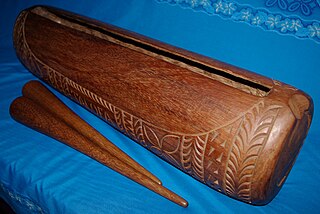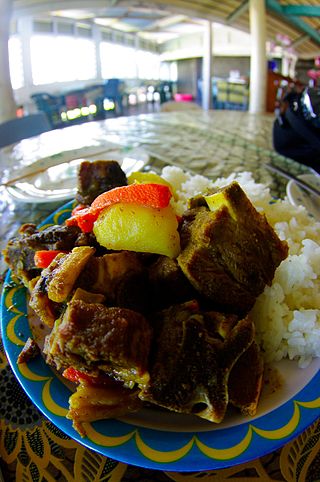
Tuvalu, formerly known as the Ellice Islands, is an island country in the Polynesian subregion of Oceania in the Pacific Ocean, about midway between Hawaii and Australia. It lies east-northeast of the Santa Cruz Islands, northeast of Vanuatu, southeast of Nauru, south of Kiribati, west of Tokelau, northwest of Samoa and Wallis and Futuna, and north of Fiji.

The first inhabitants of Tuvalu were Polynesians, so the origins of the people of Tuvalu can be traced to the spread of humans out of Southeast Asia, from Taiwan, via Melanesia and across the Pacific islands of Polynesia.

Tuvaluan, often called Tuvalu, is a Polynesian language closely related to the Ellicean group spoken in Tuvalu. It is more or less distantly related to all other Polynesian languages, such as Hawaiian, Māori, Tahitian, Samoan, Tokelauan and Tongan, and most closely related to the languages spoken on the Polynesian Outliers in Micronesia and Northern and Central Melanesia. Tuvaluan has borrowed considerably from Samoan, the language of Christian missionaries in the late 19th and early 20th centuries.
The music of Polynesia is a diverse set of musical traditions from islands within a large area of the central and southern Pacific Ocean, approximately a triangle with New Zealand, Hawaii and Easter Island forming its corners. Traditional Polynesian music is largely an inseparable part of a broader performance art form, incorporating dance and recital of oral traditions; most literature considers Polynesian music and dance together. Polynesian music expanded with colonial European contact and incorporated instruments and styles introduced through a process of acculturation that continues to the present day. Although the European tradition of hymn-singing brought by Christian missionaries was probably the most important influence, others are evident; Hawaii's influential kī hōʻalu music incorporated the Spanish guitar introduced in the late 19th century, and later introduced the steel guitar to country music. Hip hop and R&B influences have created a contemporary Urban Pasifika music genre with a strong Polynesian identity and supported by the annual Pacific Music Awards in New Zealand.
The music of the Cook Islands is diverse. Christian music is extremely popular. Imene tuki is a form of unaccompanied vocal music known for a uniquely Polynesian drop in pitch at the end of the phrases, as well as staccato rhythmic outbursts of nonsensical syllables (tuki). The word 'imene' is derived from the English word 'hymn'. Likewise the harmonies and tune characteristics / 'strophe patterns' of much of the music of Polynesia is western in style and derived originally from missionary influence via hymns and other church music. One unique quality of Polynesian music is the use of the sustained 6th chord in vocal music, though typically the 6th chord is not used in religious music. Traditional songs and hymns are referred to as imene metua.
The music of French Polynesia came to the forefront of the world music scene in 1992, with the release of The Tahitian Choir's recordings of unaccompanied vocal Christian music called himene tārava, recorded by French musicologist Pascal Nabet-Meyer. This form of singing is common in French Polynesia and the Cook Islands, and is distinguished by a unique drop in pitch at the end of the phrases, which is a characteristic formed by several different voices; it is also accompanied by steady grunting of staccato, nonsensical syllables.

The music of Tokelau occurs in the atolls of Atafu, Nukunonu, and Fakaofo. It is dominated by communal choral activity in harmony, with percussive accompaniment including log drums (pate), pokihi and apa. Nukunonu is notable for traditional song and dance.

Niutao is a reef island in the northern part of Tuvalu. It is one of the nine districts (islands) of Tuvalu. It is also one of the three districts that consist of only one island — not counting the three islets inside the closed lagoon. Niutao has a population of 582.

From the American Revolutionary War to the start of the American Civil War, American music underwent many changes. The folk vernacular traditions diversified and spread across the nation, while a number of prominent composers of European art music also arose.

The latter part of the 19th century saw the increased popularization of African American music and the growth and maturity of folk styles like the blues.
The Congregational Christian Church of Tuvalu, commonly the Church of Tuvalu, is a Christian church which is the state church of Tuvalu, although this status merely entitles it to "the privilege of performing special services on major national events"; its adherents comprise about 86% of the 11,600 inhabitants of the archipelago.

The following outline is provided as an overview of and topical guide to Tuvalu:

The cuisine of Tuvalu, a state in the Central Pacific (Oceania), is based on the staple of coconut and the many species of fish found in the ocean and the lagoons of the atolls of Tuvalu. Pulaka,, or swamp taro, is an important source of carbohydrates. Rice now forms an important part of the diet. Coconut is used in different forms with coconut water, coconut milk and the flesh of the coconut being used to flavour dishes. Various desserts made on the islands include coconut and coconut milk, instead of animal milk.
A fakanau is a traditional Tuvaluan male dance, accompanied by singing and rhythmic clapping.

Women have been a vital part of history and culture in the geographic area known as Oceania today. Women in Oceania have diverse cultural identities which relate to the geography of the continent and the social structures of the people living there. Their evolution, culture and history coincide with the history of Oceania itself.

Women in Tuvalu continue to maintain a traditional Polynesian culture within a predominantly Christian society. Tuvaluan cultural identity is sustained through an individual's connection to their home island. In the traditional community system in Tuvalu, each family has its own task, or salanga, to perform for the community. The skills of a family are passed on from parents to children. The women of Tuvalu participate in the traditional music of Tuvalu and in the creation of the art of Tuvalu including using cowrie and other shells in traditional handicrafts. There are opportunities of further education and paid employment with non-government organisations (NGOs) and government enterprises, education and health agencies being the primary opportunities for Tuvaluan women.
Gerd Koch was a German cultural anthropologist best known for his studies on the material culture of Kiribati, Tuvalu and the Santa Cruz Islands in the Pacific. He was associated with the Ethnological Museum of Berlin. His field work was directed to researching and recording the use of artefacts in their indigenous context, to begin to understand these societies.

The fatele or faatele is a traditional dance song of Tuvalu. Dancing songs are the most common type of traditional Tuvaluan song, with other traditional dance styles including fakanau and fakaseasea.

The Art of Tuvalu has traditionally been expressed in the design of clothing and traditional handicrafts such as the decoration of mats and fans. Tuvaluan clothing was traditionally made from Fala leaves.

The fakaseasea is a tradition dance song of Tuvalu. Dancing songs are the most common type of the traditional Tuvaluan songs, with other tradition dance styles including fakanau and fatele.








